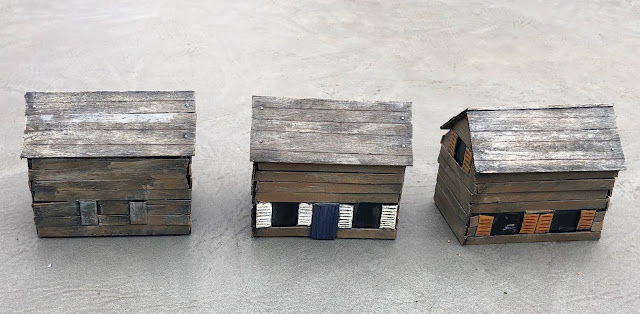For our Sappy Nappy multiple table games and the Russia 1812 events in particular, I needed some more lightweight, sturdy, and inexpensive buildings. Thus, I scratch built a set of 10 structures.
The basic construction is foam board (not insulation board). It's actually quite difficult to cut that stuff smoothly!
I did straight and gabled (ie, the ends as above) segments in 2.5" and 3.5", and from those 4 basic parts assembled 4 different sizes of buildings.
These are the smallest, 2.5" square.
These next two are 3.5" on the gabled side, and 2.5" on the straight side.
The walls were put together with white (PVA) glue an straight pins.
The wood is cut and glued on craft sticks, etc.
The doors and shutters are made from the same materials.
This next set of three is the opposite, 2.5" gabled sides, and 3.5" straight sides.
They are meant to represent pretty basic. no frills rough wooden peasant house type structures.
Thus any decorative paint is reserved for the shutters and doors.
The roofing is made from thin sheets of balsa, again affixed with white glue and straight pins.
The final 2 buildings, and the largest of the set, are 3.5" on all four sides.
I am still debating whether to add chimneys to them.
It would improve the look, but cutting the square wooden dowels on the proper angle, and attaching them may prove more fussy than I want to deal with.
We'll see; maybe at some point I will add them!
















Neat looking buildings. How do they scale with your models?
ReplyDeleteinevitably, buildings for 25/28 mm figures, other than skirmish games, must be out of ground scale. No worries, one of our figures represents many men, so one of our buildings represents many buildings. Thus the footprint of the buildings is kept small. The height is probably reduced in scale as well, but not as much as the other dimensions. This is similar to the approach that the "Hovels range of 25 mm buildings took, and that works very well.
DeleteSimple and practical solution to mass producing buildings Peter!
ReplyDeleteThanks, Keith!
DeleteThese will look great on the table Peter. I'm not sure I'd bother adding chimneys. Didn't many of them just have simple holes in the roof?
ReplyDeleteI may try adding a chimney to the larger buildings and see how irt looks and how much bother it is! :-)
DeleteVery effective!
ReplyDeleteThank you, Aaaron!
DeleteNice building program. You can see why Moscow burning when looking at these!
ReplyDeleteOh my gosh, yes! It doesn't look like the Russians used stone much for anything but the most important structures.
DeletePerfect
ReplyDeleteThanks, Neil!
DeleteGreat looking rapid Russian buildings, I'd be tempted to put them on a hardboard base , just to finish them off? I know some southern German buildings of the period didn't use chimneys but allowed the smoke to go out of the eaves. I was reading in my Russian wooden church book that I got for my birthday that they would build the church ( which would have been the most complicated building in all probability) in a day, admittedly they started in the middle of the night and involved the whole community but it does show how rapidly they could put these structures up. I also think they factored in occasionally burning down as a fact of life in Russia!
ReplyDeleteBest Iain
Thanks, Iain. I wouldn't base these rough and ready structures, myself. Some fancier houses, maybe. Still debating chimneys!
DeleteI agree with the others. They are very effective and could be used right up to modern times.
ReplyDeleteThanks, Chris. They are probably suitable from about the 1400;'s on as rough dwellings.
Delete